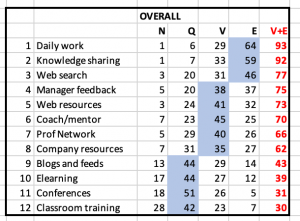 In PART ONE of this analysis I considered the results of the Learning in the Workplace survey (which asks respondents to rate 12 different ways of learning at work as Not Important (N), Quite Important (Q), Very Important (V) or Essential (E) and ranks them by their aggregated Very Important and Essential (V+E) scores (see chart right), and how people with different characteristics (ie country of working, organisational size, gender, age, and role in the organisation) diverge from this overall pattern.
In PART ONE of this analysis I considered the results of the Learning in the Workplace survey (which asks respondents to rate 12 different ways of learning at work as Not Important (N), Quite Important (Q), Very Important (V) or Essential (E) and ranks them by their aggregated Very Important and Essential (V+E) scores (see chart right), and how people with different characteristics (ie country of working, organisational size, gender, age, and role in the organisation) diverge from this overall pattern.
In PART TWO I now take a look at each of the 12 ways of learning and compare the results of each of the different profiles (discussed in Part One) against the overall profile, and discuss some further implications for modern workplace learning. In this part of the analysis, I am going to look at this topic in two ways:
- Learning from the internal work environment: Daily work, Knowledge Sharing in your Team, Manager Feedback, Coach/Mentor, Elearning, Classroom training, and Company resources.
- Learning from the external environment: Web search, Web resources, Pofessional networking, Bogs and feeds, and Conferences
(1) LEARNING FROM THE INTERNAL WORK ENVIRONMENT
DAILY WORK and KNOWLEDGE SHARING IN YOUR TEAM appear at the very top of the ranking (both considered Essential ways) of learning) and when we look at all the different profiles (see charts below), there is very little divergence from the pattern from any group, except for a couple of instances at the bottom of KNOWLEDGE SHARING list. (Note, divergence of +5 or +5 or more from the overall profile is highlighted in yellow.)
It is particularly revealing that Line Managers appear at the bottom of this list, although they see still knowledge sharing as an essential way of learning at work, they seem to value it slightly less than others in the organisation. When it comes to encouraging a knowledge sharing culture in an organisation therefore, line managers are key to its success, so this suggests that particular efforts need to be made to support line managers and help them its organisational value

Two other ways of learning at work are from MANAGER FEEDBACK (ranked 4th) and from a COACH/MENTOR (ranked 6th). The two listings are shown below.
The MANAGER FEEDBACK list is interesting. There is quite a bit of divergence from the overall profile (of it being a Very important way to learn) – which means that this is something that needs to be considered carefully. There are 3 points to make:
- The youngest employees seem to value manager feedback, whilst the older employees see it as far less so.
- Females seem to value it slightly more than males
- Across country groups, some regions (like Oceania and Asia) value it more than others (Continental Europe and the USA)
When it comes to COACH/MENTOR (another Very important way of learning)
- The youngest employees again seem to value this much more than older employees, with Under 30s for instance seeing it as Essential.
- There are a couple of regional groups (Middle East and Africa, and Asia) where it is particularly valued
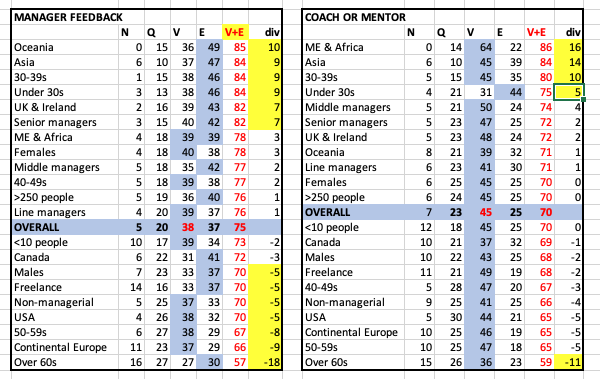
The traditional ways of learning at work rank very low on the list, ie. CLASSROOM TRAINING (ranked 12th) and ELEARNING (ranked 10th) are both only seen as Quite Important as a way of learning at work.
With CLASSROOM TRAINING, it is interesting to see that the youngest employees value this as a way of learning – maybe because this is due their recent learning experiences at school and college – whilst the oldest employees value it the least. And, interesting, respondents from the USA valued it quite poorly as well.
With ELEARNING, once again the youngest employees value it quite highly, but interestingly the over 60s top the list. And at the bottom end, it is again interesting to see Line Managers down there. Could this be because they see Elearning as something that interrupts the daily work too much?
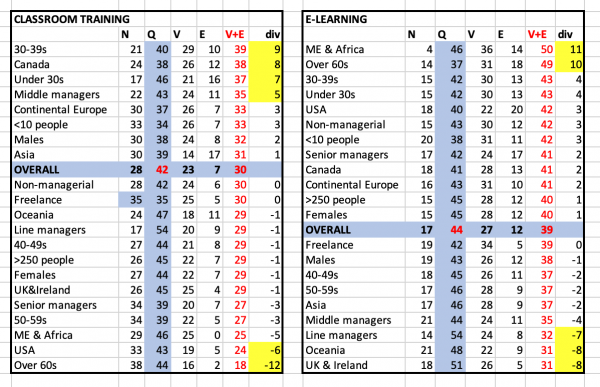
Finally, then what about internal COMPANY RESOURCES (ranked 8th and rated overall as Very important)? There is another varied pattern. Here are 4 observations
- There is clearly a cultural factor here in that some country groupings seem to value it more than others.
- The youngest employees again appear at the top of the list; in fact they seem to value everything they can get their hands (internally) to help them learn at work!
- Freelances only value internal resources as Quite important
- Organisations with <10 people also only value them as Quite Important, and appear at the bottom of the list. As was pointed out in Part One, this is probably due to budget considerations.
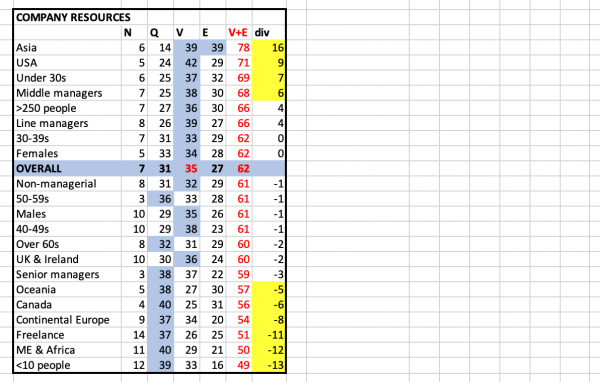
Summary
So what can L&D take away from this analysis of learning from the internal work environment. Here are some key things they can do (together with where you can find more information in this MWL 2020 resource)
- Help line managers
- understand the importance and need for being a modern manager that nurtures their team members and provides feedback etc to those who need it, particularly youngest employees – see 2 – The modern manager, and
- understand the importance of and enable knowledge sharing in their team – see section 7 – Support social learning and collaboration,
- provide opportunities for mentoring and coaching where appropriate – see section 8 – Help managers with on the job development
- Provide classroom training (in modern ways) – see section 11 – Design modern approaches to training, but only where appropriate – see section 12 – Facilitate problem solving
- Shift from (traditional) elearning (that takes up valuable time at work) to on demand resources, that are available in the flow of work – See section 9 – Create flexible resources for on demand use
- Help individuals become more self-sufficient and self-reliant in the workplace, rather than rely on being spoonfed – see section 3 – The modern worker
(2) LEARNING FROM THE EXTERNAL ENVIRONMENT
When it comes to WEB SEARCH (ranked 3rd, and rated overall as Essential) and WEB RESOURCES (ranked 5th, and rated overall as Very important), there are some interesting observations across the two lists.
- The pattern is reversed in terms of age, with the youngest employees right at the bottom of the list and the oldest at the top.
- The same goes with management roles, line managers value it less highly than middle and senior managers, and in fact for line managers, web search drops down from Essential to Very Important.

When it comes to PROFESSIONAL NETWORKING (ranked 7th and rated Very Important overall) and BLOGS AND FEEDS (ranked 9th and rated Quite important overall), the pattern described above continues, but additionally those working in small organisations also value these two ways of learning more highly

Finally, we look at CONFERENCES (ranked 11th and rated as Quite important). Strangely, they seem be more appreciated by those over 60 (could it be because it means a day off from the office perhaps!?!). Whilst Freelancers value them less so, as was mentioned in Part 1, this may be due to cost, and the fact they can learn in other ways from the external environment.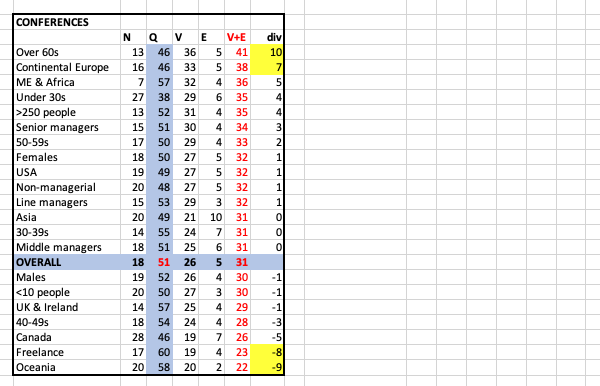
Summary
So what can L&D take from this analysis of learning from the external world. Here are 3 key things they can do (together with where you can find more information in this MWL 2020 resource).
- Help employees (particularly the youngest employees) value learning from the external world, and to take some time to do this for themselves, as well as develop the modern learning skills they need to thrive and survive. In Part 1 we saw how the Freelancers’ profile is one many will need to adopt. See particularly sections 3 – The modern worker and 4 – Encourage a daily self-learning habit.
- Help line managers understand the importance of continuous (self-)learning outside the organisation, and to provide time for this – see section 2 – The modern manager
- Curate resources and other opportunities from the external environment so that they are integrated into the daily work environment – see section 10 – Offer opportunities for continuous learning
But let’s now take a closer look at why classroom training is so unpopular.
Last updated: March 11, 2020 at 12:25 pm